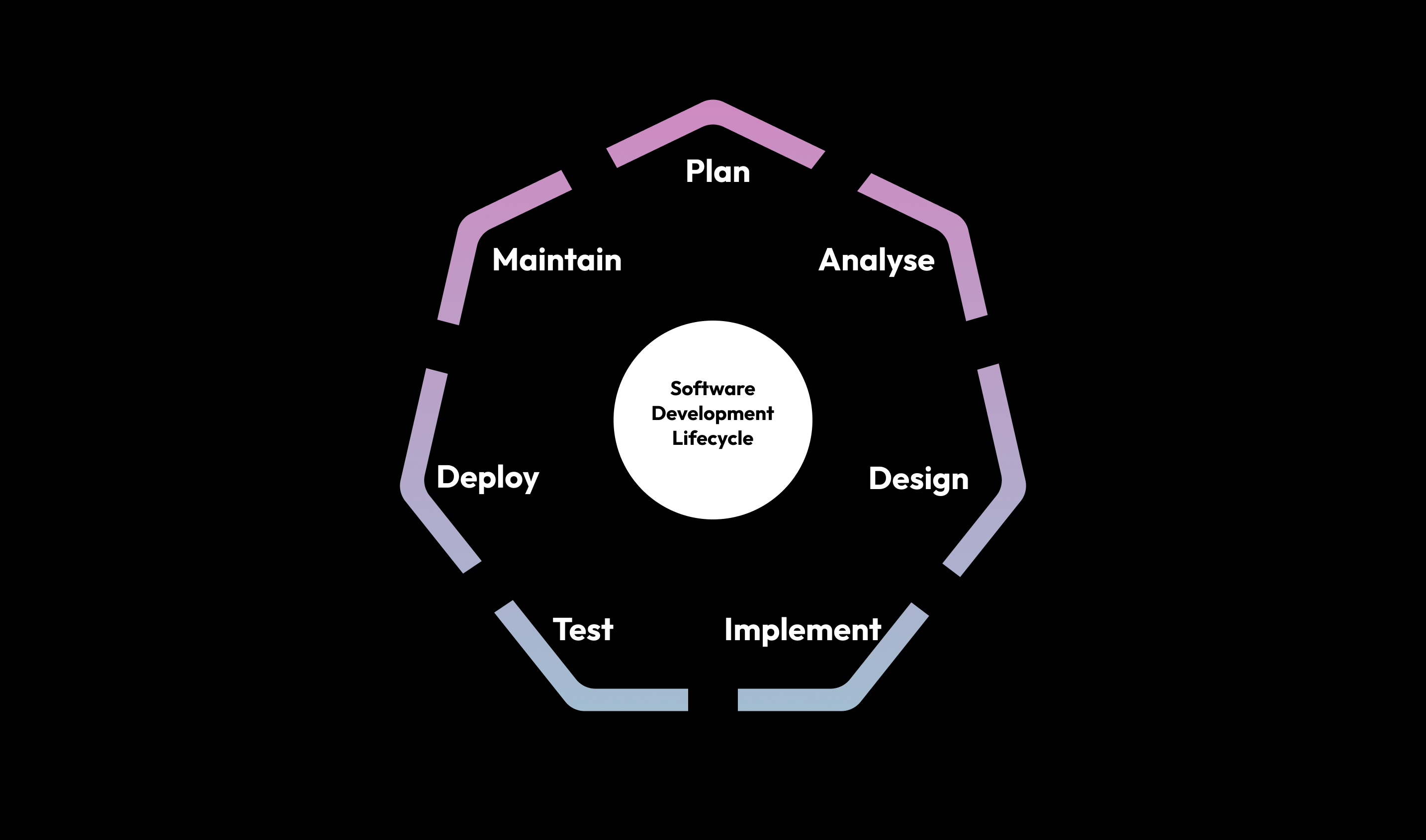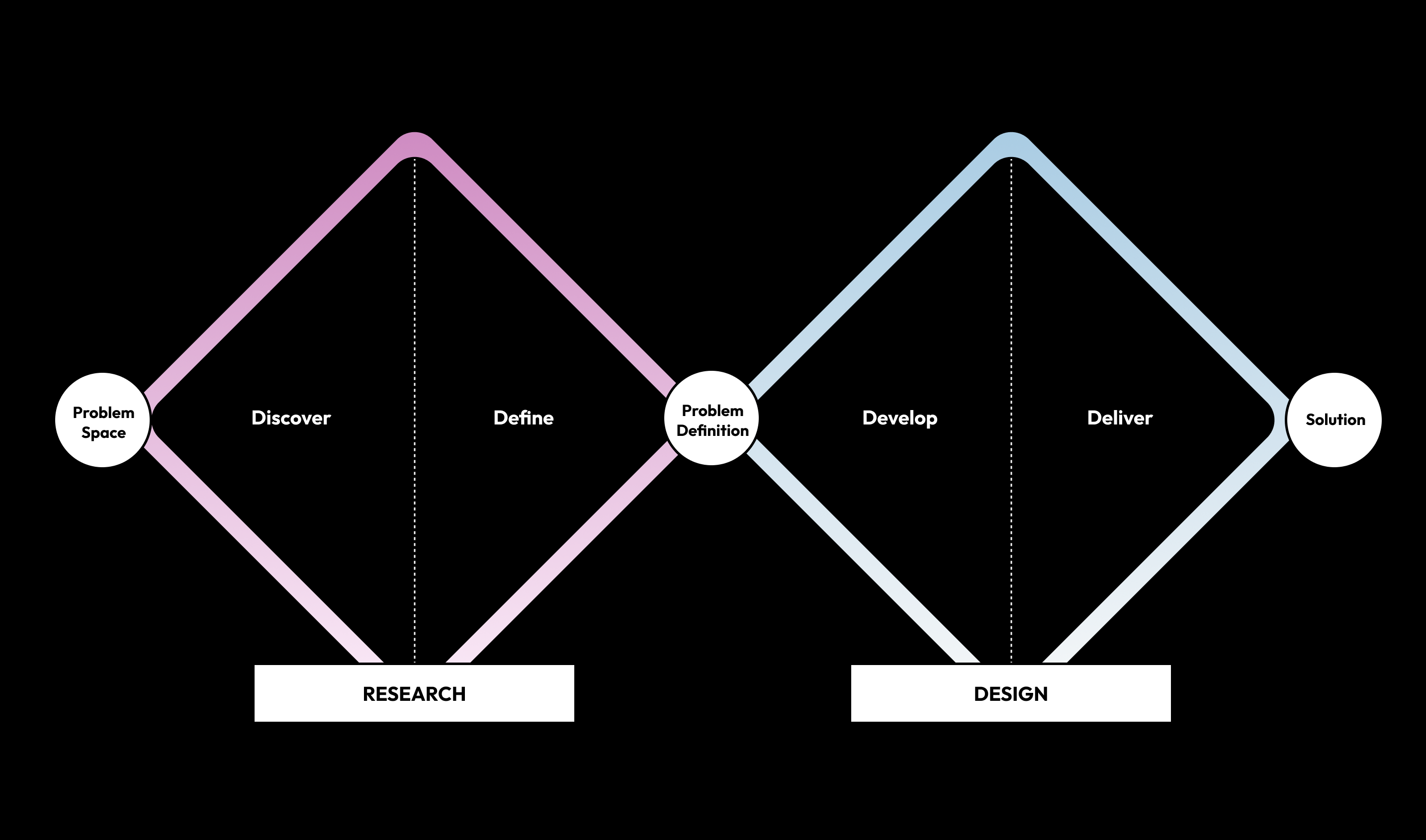Experience Design Planning Across the Software Development Lifecycle
How do you create an experience design plan that drives product and business outcomes at every stage of a project?
When planning design and development work, it’s possible to anticipate the types of design activities that will provide the most value. Design and development processes can sometimes feel at odds with each other but they don’t have to.
By mapping out every project phase and identifying the most suitable and valuable design activities in each, it can create a collaborative way of working. While every organisation, project and way of working is different, this can help you find common ground, plan ahead, reduce future effort and link insights throughout.
In this post, I’m going to use the software development life cycle (SDLC) because it provides a comprehensive set of activities. I’ll also map to the Double Diamond, a framework familiar in design.
Overview
Software Development Lifecycle (SDLC)
The SDLC is a framework that follows a structured process from planning through to maintaining software once it is in production. There are some variations to this process and it can be adapted when using different methodologies e.g. Waterfall, Agile, Kanban etc. This framework is often used by development teams.

Double Diamond
The Double Diamond framework, developed by the Design Council, consists of 4 phases, Discover, Define, Develop and Deliver. It promotes research, innovation and design thinking by encouraging divergent thinking in a problem space before converging on ideas that are the most viable. This framework is often used by design and innovation teams.

Let’s take a look at the different phases, where the Double Diamond intersects with the SDLC and how experience design activities can be planned for each.
1. Planning (SDLC), Discover (Double Diamond)
In the planning phase, the scope of the project is defined along with the identification of key stakeholders, team members, activities and timelines. In the planning phase, the following activities are helpful in defining the problem space and gaining a common understanding of the answers to ‘What problem are we trying to solve?’ ‘Why is it important to solve?’ and ‘Who is it for?’
- Data analysis - Review of any internal data sources e.g. customer feedback forms, surveys, contact centre data, analytics.
- Customer segmentation - Identification of the types of customer that would be impacted.
- Customer interviews - Depth interviews to understand the real-world impact on the customer, their context, experience, expectations, beliefs and behaviours.
- Journey mapping - Both an experience map or a customer journey map are helpful in identifying where problems exist and contribute to defining scope.
- Baseline testing - Establishing the current state of an experience using a set of measures and metrics shows where we are today and can be used to clarify where we want to get to in the future.
- Card sorting - If further analysis is required to understand the grouping of information that makes sense to users, card sorting activities will help define how things are organised.
2. Analysis (SDLC), Define (Double Diamond)
Also known as Requirements Gathering, during analysis, technical requirements, considerations and constraints, business requirements and user requirements will be defined and documented. Depending on your methodology, these could be defined as user stories, jobs to be done, ‘how might we’ statements, system requirements or a detailed document depending on regulatory or legal requirements.
- Research synthesis - sense making of all prior research activities to turn insights into user stories and success criteria. Doing this type of activity with members of the team helps to reach a common understanding.
- Refining and prioritising problem statements - It’s likely there could be multiple solutions to a problem. At this stage, analysis is conducted to refine and prioritise the problem statements by agreeing to which ones move forward into design.
3. Design (SDLC), Develop and Deliver (Double Diamond)
In the Design phase, designers and developers should continue to work together to ensure that any solution is both technically feasible and delivers on user experience goals. It’s here where solutions come to life.
- Prototyping - both high fidelity and low fidelity designs could be produced here depending on what the team needs to learn.
- Concept testing - testing prototypes with intended users provides valuable feedback on the usefulness and viability of the solution to meet user needs.
- Usability testing - with high fidelity prototypes, usability testing will identify workflow and UI issues early on so they can be fixed and re-tested.
- Content testing - content can be tested with users to ensure that it is well understood and communicates the right information.
- Tree testing - Testing existing or new information structures to make sure that users can successfully find their way through organised content.
4. Implementation (SDLC)
During implementation, designs are now ready to be built by the development team. There could be some overlap between the Design phase (implementation can begin before this phase has been completed) and the Testing phase (tests may be written during this phase rather than waiting for everything to be implemented first). It’s important that design is involved at this stage to respond to any unforeseen technical constraints or design changes.
- Training documentation - During this phase, training documentation can be produced. This could include guides for support teams to understand the new changes, how they work and how to respond to customer queries or training documentation for changes to internal systems.
5. Testing (SDLC), Deliver (Double Diamond)
Testing in the SDLC most commonly refers to unit, integration, system, security, performance and user acceptance testing, there is also an opportunity here to evaluate the solution, fix any usability errors and provide confidence metrics to stakeholders about the solution.
- Usability testing - With the solution now in a pre-production or staging environment, we can test again with users to verify end to end task success, identify any issues that need to be fixed and measure the results. These results can be compared to any baseline tests to show real improvement.
6. Deployment (SDLC)
In the deployment phase, teams are getting ready to move code from a pre-production environment into production. During this phase, it’s time to implement any analytics we need to track into production.
- Analytics tools - There are many tools available depending on what you want to track e.g. Google Analytics, HotJar, MixPanel. These all track how users are interacting with pages, elements on the page and how they navigate through multiple pages.
- A/B testing - If you’ve decided to perform an A/B test, tracking metrics to determine success should be set up.
- Customer feedback - Once in production, customer feedback can be obtained through the use of a survey tool e.g. Qualtrics, Survicate
7. Maintenance (SDLC), Discover (Double Diamond)
In the world of software development, nothing is ever really finished. As time goes by, things change and what previously worked well may need to be updated or adapted as technology progresses and ideas are developed.
- User feedback - monitoring feedback channels allows for the identification of any issues. These channels could include things like contact centres, surveys, social media, google or trust pilot reviews.
- Analytics tools - usage data can be monitored over time to identify any anomalies or unexpected issues that occur requiring further investigation.
Conclusion
Experience design activities can add value at every stage of software development when the right activities are conducted at the right time. By thinking about each phase of the project early it makes it easier to include experience design activities into the project plan and timelines. It helps everyone to understand what gets done when, by who and how those activities will contribute to the success of the end product.
Need Help?
If you’re new to experience strategy, user research, and usability or want expert input, we’re here to support you. Whether you're looking for advice, a helping hand or a full independent review, get in touch.
Or, if you’re after a fast way of getting feedback on your prototype or website, check out our online usability evaluations.
